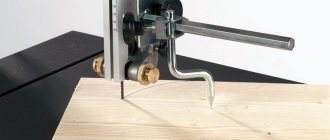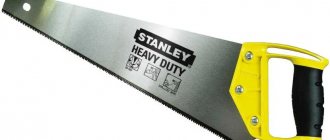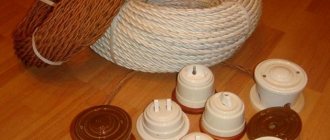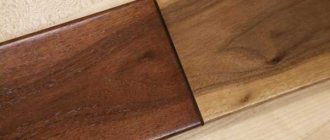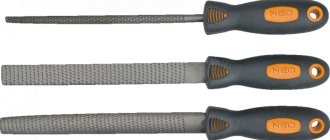The ring cutting method is used in cases where it is necessary to obtain a hole of a certain size in some material. A ring attachment that fits onto a drill, or a wood bit, is a device used by craftsmen for drilling in wood.
What is a wood crown?
A spray-coated attachment for processing plywood, chipboard, plastic, metal - a well-known device called a crown for drilling wood and other materials. It looks like a bowl with teeth located along the edge of the rim. It is put on a special drill chuck and rotates thanks to the power tool. The depth of the hole can vary, from a few millimeters to several centimeters. The number of teeth on it depends on the diameter of the cutter: the larger the wood crown, the greater the number of teeth on it. A typical set of ring nozzle is equipped with the following elements:
- head with cutting teeth;
- shank;
- central drill.
Why do you need a wood crown?
A ring attachment for a drill, with which you can easily drill a hole of any diameter, is widely used in repair work. A well-sharpened professional wood crown for socket boxes allows you to get neat recesses in walls, drywall, and wooden structures of the required size. A clean cut with a smooth inner surface without chips or burrs can be made using this attachment. There is no need to center the surface before drilling; sawing occurs quickly and quietly.
Is it possible to drill into metal with a wood crown?
A core drill does an excellent job of its main task - drilling holes. Experts confirm that it can be used to process not only wood. A crown for holes in wood, made of special grades of coated steel, is capable of processing more durable materials. With its help it is easy and simple to make a hole in non-ferrous metals of any hardness. When planning to work with complex materials, you should choose a drill with HCS markings; such a crown for hard wood and metal can easily cope with any task.
Most common devices
All devices of this type are made of durable tool steel. The denser the array, the stronger the cutting edge should be. Any tool, in addition to the cutting edge, must have a working part and a clamping shank.
Twist drills
This is a classic type of tool, almost everyone is familiar with them; it is this type that every person means by the concept of a drill. The model range for wood processing here ranges from 3 to 52 mm.
Interestingly, products with a diameter of up to 10 mm are made smooth. But everything that goes higher often has a hexagonal clamping shank. It is necessary because the load during drilling increases many times and the tool is able to rotate in the chuck.
Standard twist drills.
Important: the entire model range, except for the crown cutter, designed for working with wood can be distinguished by the presence of a sharp guide shank. It is the first to enter the array and prevents the tool from slipping or deviating to the side.
When working with such attachments, the number of revolutions set on the drill is of great importance; if these parameters are neglected, then in the best case, you will not be able to drill a hole, in the worst case, you can “burn” the drill at high speeds when overheated or even break it.
- So small drills, the diameter of which does not exceed 14 mm, work best on soft wood at 1800 rpm. If you have to work with hard wood, then the number of revolutions is reduced to 750.
Hex shank.
- The average diameter of the tool is considered to be from 16 mm to 25 mm. For this direction, experts recommend setting 1500 rpm on soft wood. Hard material is drilled at 500 rpm.
- From the upper threshold of the medium diameter to the maximum dimensions of 52 mm, you should work at 500 rpm on soft material and at 250 rpm on hard material.
The length of the working surface of the drill also varies. Here everything directly depends on the diameter of the tool; the thicker the drill, the longer it can be. The minimum length is considered to be 80 mm, the maximum is limited to 600 mm.
Tool for making large diameter holes.
In addition, it would be useful to maintain a reasonable ratio between the diameter of the cutting surface, the size of the drill and the power of the drill itself. So, for example, a fifty-millimeter drill with a length of 60 cm will weigh about 3 kg and not every drill is capable of turning it even at idle.
Feather drills
This is a rather specific tool; the sizes of holes that can be made with their help range from 10 to 55 mm. Their main advantage is their simplicity of design and low cost. The price for pen models is 10 times lower than for twist drills.
But they have a serious disadvantage. It is quite problematic to drill a deep hole with feather drills, this is due to the fact that there is no mechanism for removing chips. Essentially, it is a flat, multi-directionally sharpened knife with a guide spike in the middle.
Feather drills.
All models of this type have a hexagonal shank, this is caused by heavy load during operation.
Most often, such a tool is used to work with thin boards, plywood, as well as chipboard, USB or fiberboard.
- As for the number of revolutions, they are higher here than in spiral versions. Thus, feather nozzles with a diameter of up to 25 mm operate at 2000 rpm on soft wood. Hard material is processed at 1500 rpm.
- Accordingly, wide nozzles 30 - 55 mm, drill on soft material at 1500 rpm. For hard rocks, no more than 1000 rpm should be set.
Adapter for deep holes.
Important: the length of a standard pen nozzle does not exceed 150 mm. If there is a need to increase the length, adapters are used that can extend up to 450 mm.
Forstner drills
It is these attachments that are often confused with classic crowns. Their spectrum of action is quite wide. With this nozzle you can easily make a blind hole of a perfectly regular shape with a flat bottom. Due to this feature, they are often used in furniture production.
In addition, if extensions are inserted, the forstner drill bit can be used as wood core bits for deep drilling. But the maximum diameter here does not exceed 50 mm.
Forstner drills.
In these nozzles there is also a dependence of the diameter on the number of revolutions.
| Nozzle diameter | Number of turns on soft wood | Number of turns on hardwood |
| 10 – 15 mm | 2400 rpm | 500 rpm |
| 20 – 25 mm | 1500 rpm | 500 rpm |
| 30 – 50 mm | 1000 rpm | 250 rpm |
Blind hole.
Wood crowns
A classic crown for drilling wood is an improvised cup, along the perimeter of which there is a cutting toothed surface. It is mounted on a special chuck that has a separate drill in the center. For creating wide holes in sheets or boards up to 60 mm thick with your own hands, these devices are ideal.
A selection of crowns.
Advice: although the range of such crowns is quite wide, experts say that an inexperienced person can drill by weight with a hand drill with a cup no larger than 100 mm. Already a diameter of 120 mm or 127 mm is better to clamp into a drilling machine.
Wood crowns with a large diameter of 150 mm are rarely used by amateurs; these attachments are closer to professional ones, since working with such a tool requires fairly powerful equipment, and not everyone can afford it.
A special niche among such tools is occupied by a wood crown cutter. The price of these nozzles is serious, but with their help you can easily make holes up to 150 mm deep. The only drawback of this tool is the inability to make blind holes.
Drilling deep holes with a hole saw.
The cutting edge here runs not only along the edge, but also along the entire outer surface of the tool. Thanks to this innovation, the nozzle enters the material much easier, as chips are removed. When working on a machine, with this tool you can make a side cut; with a hand drill, it is almost impossible to make an accurate side cut.
What is better: a wood crown or a ballerina?
Disputes continue in the furniture-making community about which tool to give preference to: a hole cutter or a ballerina jig. This wood core drill cuts a hole thanks to two sharply sharpened plates. By adjusting the distance between them, you can get a recess of any size. The main difference between the devices is that the crowns have a fixed size, and with the help of a ballerina you can drill a hole of any diameter. There is no definite answer which is better, it all depends on the specific type of work. When carving wood, a ballerina is best, and it is more convenient to drill holes in ceramics with a coated crown.
Drill bits
Using a core drill, holes of different diameters (25-150 mm) are obtained. Different materials are used to make such cutters, but their design does not change. Select the product you are interested in on the website and buy it in our online store.
Drill bit components:
- metal glass. The material of the cutting edge is determined by the purpose of the part (carbide crown, solid metal);
- pilot drill. Allows you to clearly position the center of gravity of the glass relative to the axis of the hole;
- shank. Designed for reliable fastening of the part in the drilling tool chuck.
Advantages of annular cutters:
- the opening is cut along the contour of the crown, so there is no need to use high-power equipment;
- combined with various types of installations (drilling tools, lathes and milling machines);
- remove a lot of material in one drill pass;
- high efficiency;
- possibility of repeated sharpening while maintaining alignment;
- low noise level.
Types of core drills
Since the surfaces being processed have different densities, structures and other characteristics, the appropriate cutter should be purchased for a particular material.
- Crown for concrete.
It is used to drill through openings into which utility networks (plumbing, communication cables, ventilation system, etc.) are then laid. - Wood crown.
It simplifies the processing of not only wooden surfaces, but also drywall and plastic. The main thing is that the materials are not too strong and hard. - Metal crown.
Designed for making holes in sheet metal.
The “Order” store sells ring cutters for various purposes at low prices, with which you can quickly and accurately drill holes of the required diameter and depth.
Diamond bits for hard materials
A drill with a diamond coating on the cutting edge provides the most accurate holes in concrete surfaces and reinforced concrete with varying degrees of reinforcement. The bit confidently drills through crumbling layers and easily cuts through metal encountered along the way. At the same time, the treated surface does not crack and maintains its integrity.
The use of such crowns is convenient because little debris and dust are generated during drilling, which makes the process more comfortable. And the ability to replace worn segments allows you to save on the purchase of a new core drill.
How to choose a crown for wood?
Crowns designed for working with wood are easy to distinguish from others. They are painted black and made from metal alloys. A set of wood crowns looks like a device consisting of several cutting blades that can be replaced. Unlike a fixed cutter, such a tool does not always produce a high-quality cut. The harder the surface that needs to be drilled, the lower the drill speed should be. A wood inlaid crown differs in performance, which depends on several parameters:
- cutter material;
- tooth sharpening forms;
- number of teeth.
Wood crown sizes
The standard size of the socket box is 6.8 cm. Any set of ring cutters has a suitable attachment. In addition to this, many craftsmen use large-diameter wood crowns to drill a variety of technological and decorative holes. The size of the shank depends on the size of the device itself; for holes less than 65 mm in diameter it is recommended to use a shank of about 19 mm, for large recesses - from 3 cm. The following sizes of crowns are considered the most popular:
- 20 mm;
- 65 mm;
- 100 mm;
- 110 mm;
- 120 mm;
- 127 mm;
- 130 mm;
- 150 mm.
Scope of application of the tool
The main task for which a core drill is used for wood is cutting a through hole. In most cases, it will be needed for the socket box. Also, in addition to a solid wooden surface, you can drill with this or a similar tool in other materials with similar characteristics or hardness:
- plywood;
- Chipboard or OSB;
- plastic bars;
- non-ferrous metals;
- drywall, etc.
For processing workpieces that are stronger than wood, it is preferable to choose core drills made of high-carbon steel (HCS) coated with sputtered carbide grains. If you choose high-speed cutting grades (HSS), it is recommended to give preference to more durable alloys similar to P12 or P18. They have higher durability than P6M5.
Using a crown without a center drill
According to current standards, the crown for socket boxes is selected with a circumference of 6.8 cm. However, it is often necessary to make larger holes, for example, 150 or 160 mm. Also, for technological or decorative purposes, craftsmen make 200 mm for wood.
To make holes less than 65 mm in diameter, you will need a holder with a 19 mm shank. If a large wood crown is used, for example, 90-110 mm or even 125 mm, then a reinforced holder of at least 3.2 cm in circumference must be used.
The number of teeth on the working part directly depends on the size and dimensions of the tool used. The larger the dimensions, the more teeth.
Segment saw for wood, 7 blades
A positive factor is a clean, smooth cylindrical surface inside simultaneously with the formation of a large hole in circumference in a short period of time. After working with the tool, the inner surface does not require additional processing or deburring, since the high cutting speed removes all possible flaws.
An important quality is that the selected area does not need to be centered in advance or drilled around the perimeter to make cutting easier and reduce stress. Accordingly, the final quality increases and the processing speed increases.
Wood crowns - ranking of the best
Ready-made sets of ring drills are reliable and safe. The TOP of the best models of adjustable crowns for wood is as follows.
- The drilling set “Bison 29554-H15_z01”
consists of 15 items, the diameter of the bits varies from 1.9 to 12.7 mm. The centering drill is made of durable HSS steel. The set copes with different types of materials - wood, plastic, chipboard, plasterboard. - “MATRIX 70472”
– bimetallic wood crowns made of carbon steel, in a convenient case for storage and carrying. The set is completed with two holders and a centering drill, the maximum diameter of the bit is 2.8 mm. - “Bosch 2609255634”
- the model is compatible with any type of drill. The diameter of the holes that can be drilled using drills is from 46 to 81 mm. The wood bit provides a drilling depth of up to 3.1 cm, the weight of the set is only 500 g.
DIY wood crown
Any craftsman may encounter a situation where a drill of a suitable diameter is not at hand. For work that does not require high precision and accuracy, you can make a wood crown for a rosette yourself in a couple of hours. The list of materials is minimal: a metal pipe of the required diameter, a “fist” from a door hinge, a drill, a screw, a rectangular steel plate.
- In the “fist”, using a vice, you need to drill a hole corresponding to the diameter of the drill.
- On the side of the “fist”, at a distance of at least 1 cm from the edge, another threaded hole should be made, intended for a fixing screw.
- Using a grinder, you need to make cuts along the edge of the pipe that imitate teeth.
- Weld a plate on the back of the pipe, in the center of which make a hole for the drill.
- To assemble the structure, a drill is inserted into the “fist” and secured with a screw. The lower part of the drill is placed in the crown, and the upper part is placed in the tool chuck (drill or screwdriver).
How to use a classic crown
Every good owner should have a set of wood crowns. Moreover, the price of the simplest models for amateur use often does not exceed $5. And this tool is used quite often, especially in private homes.
For professionals, of course, there is a disproportionately larger range of similar products, but, firstly, it costs more, and secondly, it is not a fact that you will need it.
Standard set.
- Initially, it will not be superfluous to understand what is actually included in the standard set. Often these are 10 - 12 running working attachments, ranging from a minimum diameter of 18 mm and ending with 50 mm, a maximum of 70 mm. There must be a central guide drill; the diameter may vary, but most often it is 6 mm. Plus 2 basic cartridges and a hexagon for fixation.
- The chuck itself, the design is not complicated, a drill is inserted into it in the center and clamped with a fixing bolt using the hexagon included in the kit. The cutting cup is inserted from the reverse side and is also secured with a clamping nut.
- The hole on the cup into which the cartridge is inserted has an irregular shape so that the nozzle does not rotate. You need to tighten the nut firmly, as a large load is placed on the crown, and it can become loose.
Working with a crown.
- After the drill and the cutting attachment itself are securely fixed in the chuck, you can insert the chuck into the drill or machine and start working. The instructions are practically no different from the usual drilling process; the only thing you should pay attention to is the strictly perpendicular position of the tool in relation to the plane being processed.
- As already mentioned, when cutting wood products, it is important to choose the correct number of revolutions. But in any case, the larger the diameter of the hole, the stronger the vibration of the tool will be, so it is advisable to use powerful drills with an additional holding handle.
Important: the sizes of wood crowns may vary, but all products have small holes or slots. On cups of large diameter they are located on top; on small nozzles the slots are made on the side. It is through them that the wooden plug can be pushed out at the end of the work.
Side slits on the cup.
The video in this article contains additional information on the topic.
How to use wood crowns?
A core drill has the shape of a cylinder, one edge of which is made in the form of sharp teeth, and the other has a tip. A wood bit for a drill is essentially an attachment that can complement any hand tool. The cutter must be installed in a special glass and secured with a nut. The drill, which is located in the very center of the crown, is designed to determine the exact location of the center of the hole and obtain a perfect cut. If you follow the operating rules, any tools, including core drills, will last a long time.
How to sharpen a wood crown?
With active use, drills can become worn down and require sharpening. You can restore the sharpness of a wood drill bit yourself, but this will require certain skills. Maintaining the sharpening angle is an important point, without which it will not be possible to properly restore the functionality of the drill. Core drills for wood are made of soft metals, and they can be restored using hand tools and tools, for this the following are used:
- Grinder with a special grinding disc.
- Hand drill with sandpaper disc.
- Sharpener or emery machine.
